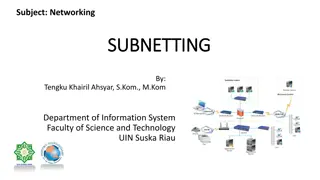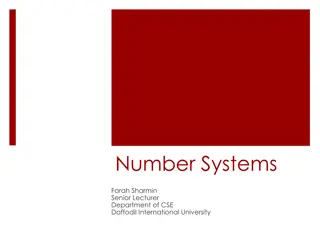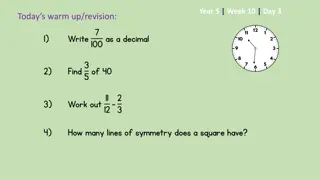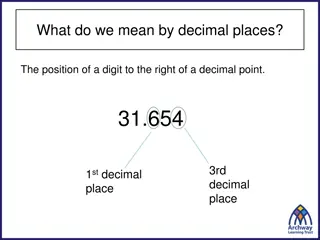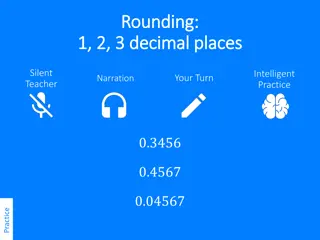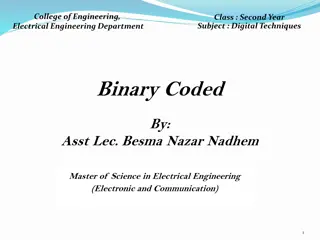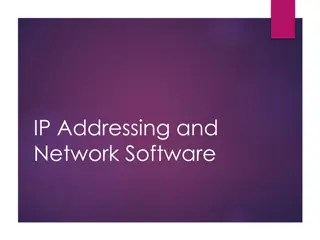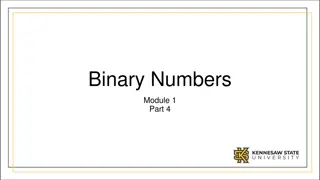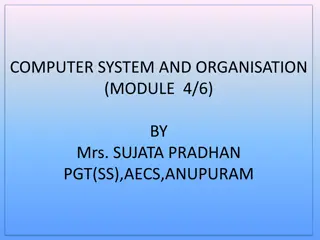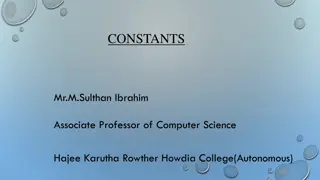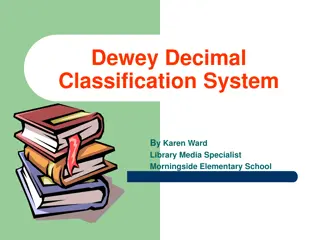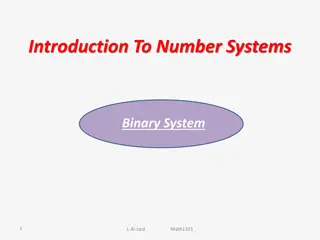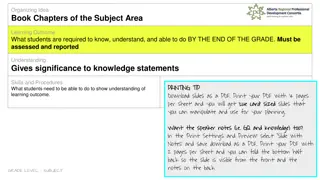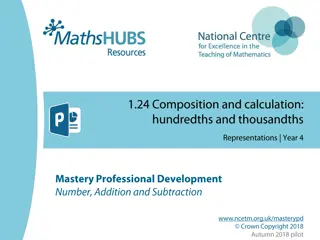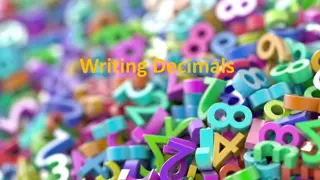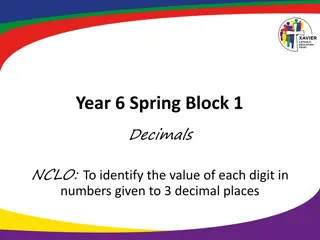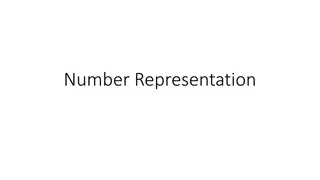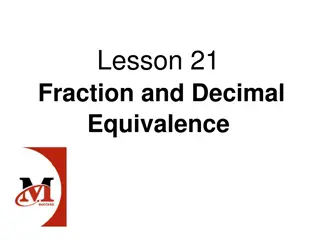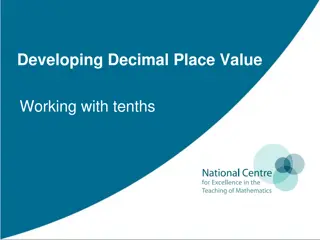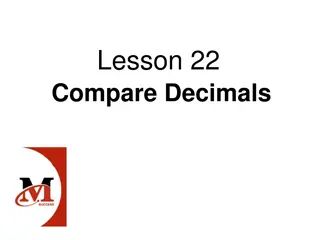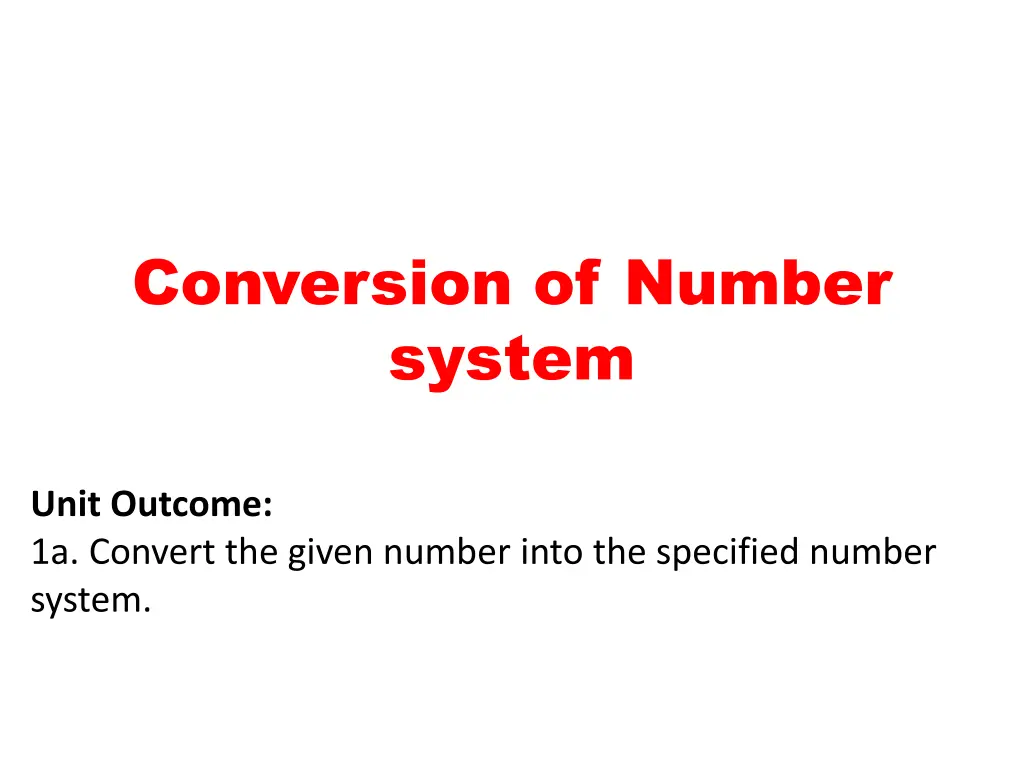
Number System Conversion: Binary, Octal, Hexadecimal to Decimal
Learn how to convert numbers from binary, octal, and hexadecimal systems to decimal. Understand the conversion process, including binary digits, octal numbers using powers of 8, and hexadecimal numbers using base 16. Practice converting examples from different number systems to decimal.
Download Presentation

Please find below an Image/Link to download the presentation.
The content on the website is provided AS IS for your information and personal use only. It may not be sold, licensed, or shared on other websites without obtaining consent from the author. If you encounter any issues during the download, it is possible that the publisher has removed the file from their server.
You are allowed to download the files provided on this website for personal or commercial use, subject to the condition that they are used lawfully. All files are the property of their respective owners.
The content on the website is provided AS IS for your information and personal use only. It may not be sold, licensed, or shared on other websites without obtaining consent from the author.
E N D
Presentation Transcript
Conversion of Number system Unit Outcome: 1a. Convert the given number into the specified number system.
How to Convert From Any Number Based System To Decimal
Contents Binary to Decimal Octal to Decimal Hexadecimal to Decimal Binary to Octal Binary to Hexadecimal Octal to Binary Hexadecimal to Binary
Binary to Decimal Decimal Octal Binary Hexadecimal
Binary to Decimal Conversion Digits: a binary digit representing a 0 or a 1. Binary numbers are of base 2 instead of decimal places such as 1s, 10s, 100s, 1000s, etc., binary uses powers of two to have 1s, 2s, 4s, 8s, 16s, 32s, 64s, etc.
Octal to Decimal Decimal Octal Binary Hexadecimal
Octal to Decimal Conversion Base or radix of Octal numbers is 8. Octal numbers uses powers of 8. Digits: Octal digit representing {0, 1, 2, 3, 4, 5, 6, 7}.
Solve Convert following Octal numbers to Decimal 1. (753.41)8 2. (123.76)8 3. (56)8 4. (235)8
Hexadecimal to Decimal Decimal Octal Binary Hexadecimal
Hexadecimal to Decimal Conversion Hex numbers are numbers of base 16. Hex numbers uses powers of 16. Digits: Hex digit representing : {0, 1, 2, 3, 4, 5, 6, 7,8,9,A,B,C,D,E,F}.
Solve Convert following Hexadecimal numbers to Decimal 1. (892.41)16 2. (A234.CD)16 3. (2F5)16 4. (AB)16
Binary to Octal Decimal Octal Binary Hexadecimal
Convert From Binary To Octal In octal 1 digit corresponds to 3 digits in binary, because for the conversion from binary to octal there are two cases 1.If decimal point is not present Start to make a group of 3 bits from rightmost bit to leftmost bit. Assign the corresponding octal digit to each group. 2.if decimal point is present Divide the given number into two parts before decimal point and after decimal point for a part of before decimal point Start to make a group of 3 bits from rightmost (LSB) bit to leftmost bit(MSB). Assign the corresponding octal digit to each group. For a part of after decimal point Start to make a group of 3 bits from leftmost (LSB) bit to rightmost bit(MSB). Assign the corresponding octal digit to each group
Binary To Octal 1011010111.0111112 = ?8 1 011 010 111 . 011 111 1 3 2 7 3 7 1011010111.0111112 = 1327.378
Binary to Hexadecimal Decimal Octal Binary Hexadecimal
Convert From Binary To Hexadecimal In hexadecimal 1 digit corresponds to 4 digits in binary, because for the conversion from binary to octal there are two cases 1.If decimal point is not present Start to make a group of 4 bits from rightmost bit to leftmost bit. Assign the corresponding hexadecimal digit to each group. 2.if decimal point is present Divide the given number into two parts before decimal point and after decimal point for a part of before decimal point Start to make a group of 4 bits from rightmost (LSB) bit to leftmost bit(MSB). Assign the corresponding hexadecimal digit to each group. For a part of after decimal point Start to make a group of 4 bits from leftmost (LSB) bit to rightmost bit(MSB). Assign the corresponding hexadecimal digit to each group
Hexadecimal to Binary Decimal Octal Binary Hexadecimal
Hexadecimal To Binary 10AF.C416 = ?2 1 0 A F . C 4 0001 0000 1010 1111 1100 0100 10AF.C416 = 0001000010101111.110001002
Solve 45A6.F216 = ?2 1CD5.A716 = ?2 (2F5)16 = ?2 (AB)16 = ?2
Exercise Convert ... Hexa- decimal Decimal 33 Binary Octal 1110101 703 1AF
Exercise Convert to verify Hexa- decimal Decimal 33 117 451 431 Binary 100001 1110101 111000011 110101111 Octal 41 165 703 657 21 75 1C3 1AF
Exercise Convert ... Hexa- decimal Decimal 29.8 Binary Octal 101.1101 3.07 C.82
Exercise Convert to verify Hexa- decimal Decimal 29.8 5.8125 3.109375 12.5078125 Binary Octal 11101.110011 35.63 101.1101 11.000111 1100.10000010 1D.CC 5.D 3.1C C.82 5.64 3.07 14.404

